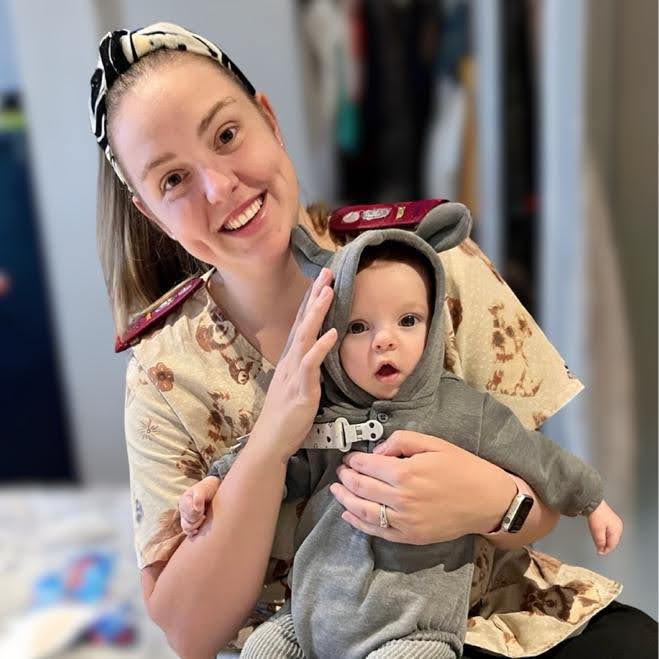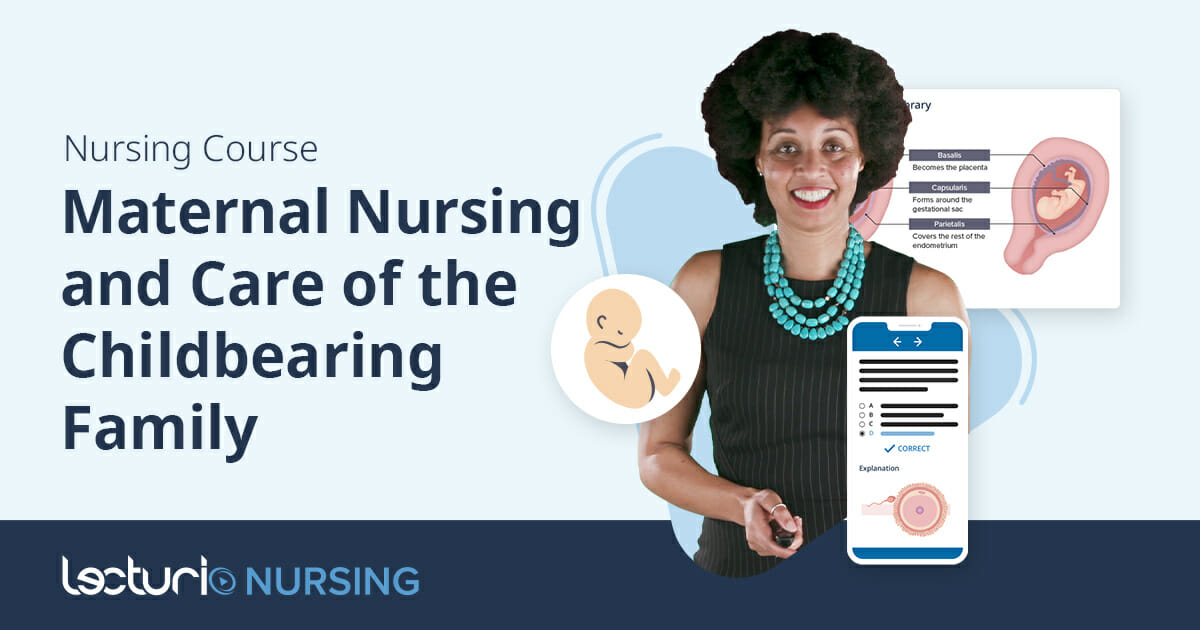This blog will discuss the most important nursing diagnoses, including those for premature babies.
When you decide upon nursing diagnoses and develop a nursing care plan for an adult or a baby, you must first assess the patient and identify any actual or potential health issues. Once you have identified these, you can create a care plan tailored to your patient’s specific needs.
Newborn Nursing Diagnoses
Here’s a list of common nursing diagnoses, how to identify them, and why they may occur.
Take the Course: Maternity Nursing
Cover all aspects of caring for the childbearing family with the all-in-one online course.
Risk of infection
Infection occurs in newborns because they have immature immune systems, which make them more susceptible to developing infections. This article also describes poor acquired immunity, environmental exposure, and traumatized tissues as other reasons a newborn may be vulnerable to infection.
The best way to detect infection is to monitor the baby’s fever and breathing. Often, doctors order blood to do this, but as a nurse, it’s important to watch for symptoms related to infection.
In terms of nursing interventions for infection, a nurse would not be able to do much, as this requires medical management but it is really important that you monitor and report any signs as soon as they are noticed.
Risk of ineffective thermoregulation
Because newborns have a large surface area in relation to their weight, they are at risk for developing hypothermia.This article also suggests inadequate subcutaneous fat and the inability to shiver may cause hypothermia in neonates.
Frequently assess a newborn’s temperature to make sure that you diagnose and treat poor thermoregulation.
Nursing interventions for ineffective thermoregulation would include keeping the infant warm and covered and educating parents or caregivers to do the same.
Risk of impaired parent-baby attachment
This could be due to the mother being a first-time parent not knowing how to care for a newborn. It could also be related to anxiety, which commonly occurs in first-time parents. You also need to assess the mother to ensure that she does not have signs of postnatal depression, as this can also impair bonding and attachment.
If the mother seems detached or stressed, keep a close eye on poor bonding and attachment.
Nursing interventions for impaired parent-baby attachment would be to monitor for signs of postnatal depression, encourage the mother to breastfeed, and ensure she performs kangaroo care if possible.
Risk of jaundice
Neonates are really susceptible to jaundice, usually because of their immature livers and because the mom has not yet gotten the hang of breastfeeding. In fact, this article suggests that 60% of babies will develop jaundice in the first week of life.
Jaundice presents as yellowing of the skin, eyes, and white stools and has to be reported accordingly.
Usually, an infant with jaundice is treated with phototherapy as ordered by a doctor. As a nurse, you can encourage adequate breastfeeding (which helps to prevent jaundice) and educate parents on the importance of only removing the baby from phototherapy for feeding and changing.
Risk for poor nutrition or breastfeeding
Poor nutrition and breastfeeding are also relatively common in the first few days. This could be because the baby lacks enough breast milk due to poor latch or low milk production. It could also be because a mother lacks the knowledge of breast milk requirements or because the mother or baby is unwell.
This would be evidenced (remember this word because it is often used in care plans) by an unsettled baby, low blood sugar in the baby, and possibly by breast engorgement in the mother.
As a nurse, you can intervene by aiding the mother in getting the correct latch and encouraging and educating her on how often to feed her baby.
Risk for impaired gas exchange
Poor gas exchange or breathing is another possible issue that neonates face (especially premature infants whose lungs have not matured yet). Tiny babies also have poor lung function and significantly increased metabolic rates, which can impair gas exchange.
This would present as low saturation and possible central and peripheral cyanosis. All of these should be monitored during routine vital sign assessments.
A typical nursing intervention would be to monitor and report any vital signs that suggest impaired gas exchange. A doctor may then prescribe oxygen therapy.
Risk for unstable blood glucose levels
Babies have particularly unstable blood glucose levels. This can be due to a mother who has had gestational or chronic diabetes, poor breastfeeding, or infection.
The only way to diagnose this is to monitor the baby’s blood glucose levels frequently.
To aid in preventing low blood glucose levels, your job as a nurse would be to encourage breastfeeding and educate the parents on the frequency and importance of adequately feeding their baby.
NANDA Nursing Diagnosis For A Newborn
The North American Nursing Diagnosis Association (NANDA) International standardizes nursing terminology, specifically nursing diagnoses. This list helps nurses create patient-centered care plans that provide standardized diagnoses.
The latest version, NANDA 12th Edition, can be found here. This document has the complete list of approved nursing diagnoses. A couple of the approved diagnoses can be applied to a newborn baby.
- Ineffective infant eating dynamics
- Risk for metabolic imbalance syndrome
- Risk for ineffective thermoregulation
- Imbalanced nutrition: less than body requirements
- Ineffective breastfeeding
- Interrupted breastfeeding
- Risk for unstable blood glucose level
- Neonatal hyperbilirubinemia
- Risk for neonatal hyperbilirubinemia
- Risk for impaired liver function
- Risk for electrolyte imbalance
- Risk for imbalanced fluid volume
- Risk for deficient fluid volume
- Excess fluid volume
- Impaired gas exchange
Nursing Diagnoses for a Premature Baby
Premature babies tend to fall into a demographic of their own. While all of the nursing diagnoses that may apply to a term baby will still apply to premature babies, others apply specifically to these patients. This is because they may be more underdeveloped than a term infant, are often a lot more ill, and require more specialized and acute care.
Here are some common additional nursing diagnoses that should be considered for a premature baby. Remember that these are in addition to those already discussed for nursing diagnoses of a newborn. These diagnoses are relatively complicated and often require diagnoses and treatment by a physician. Just remember to look for possible signs and symptoms and alert a senior if you notice anything.
Under each heading, I also briefly describe some nursing interventions. It’s imperative to remember that these babies usually require highly specialized care, and often, there is not much that a nurse can do without a doctor’s orders.
Risk for necrotizing enterocolitis
This is an illness caused by the infant having an underdeveloped intestine or too little oxygen to the intestine.
Often, these infants will feed poorly, have bloating, and vomit bile.
It’s important to ensure that you monitor for signs of necrotizing enterocolitis and report anything you feel is concerning. In terms of treatment, this will need to be managed by a doctor.
Risk for neonatal sepsis
Even more so than with a term infant, a premature infant is incredibly susceptible to infection, which can become sepsis if not managed correctly.
This would be evidenced by the usual symptoms of infection, such as fever and lethargy.
Monitor your patient for signs of neonatal sepsis and ensure that you report them accordingly.
Risk for respiratory distress syndrome
Premature babies may develop respiratory distress syndrome because the lungs have not reached maturity (which usually occurs around 37 weeks of gestation).
This would present as low saturation, difficulty breathing, chest indrawing, and cyanosis.
Nursing interventions would include keeping a close eye on your patients vital signs and reporting anything that seems abnormal.
Risk for apnea of prematurity
This is when a premature infant stops breathing for 20 seconds or more because the respiratory control center in the brain is immature.
This would be evidenced by brief periods of apnea.
Ensure that you are closely monitoring your patient for periods of apnea and that these are urgently reported to a doctor so that they can order medication.
Risk for retinopathy of prematurity
The blood vessels in a fetus’s retina begin to develop around the fourth month of pregnancy and finish by the due date. If a baby is born early, these blood vessels may stop growing normally. The retina will then develop new abnormal blood vessels.
This must be assessed as there are often no obvious early symptoms.
As a nurse, there is not much you can do to intervene in retinopathy of prematurity. Ensure that your patient is on the lowest possible flow of oxygen that their condition requires, and enquire with a doctor if you feel they could cope with less oxygen. High-flow oxygen is also associated with retinopathy in infants.
Risk for anaemia of prematurity
Often, babies have slight anemia after birth because their red blood cells are broken down faster than they are produced. Premature infants develop a more severe form of anemia called anemia of prematurity because they are unable to produce red blood cells without the help of their mother.
According to this article, a baby who has anemia of prematurity may present as pale, have tachycardia and tachypnoea, and may have a loss of weight and failure to thrive.
As with the other nursing diagnoses linked to premature infants, ensure that you monitor and report any abnormal symptoms (such as paleness) as soon as they are noticed.
Conclusion
To develop nursing diagnoses and use them to prepare a nursing care plan for the care of a neonate, you must perform a full assessment to diagnose any actual or potential health issues.
While a baby is a patient of its own, some diagnoses depend on the mother and her ability to care for and feed the baby. Such small patients need their mothers, so it’s important to remember to diagnose and develop a care plan that also considers and includes her condition. Remember that as a nurse, your focus should be on providing holistic and all-encompassing care for your patient. Don’t forget that how a mother feels and copes play an important role in how she cares for her new little baby.





